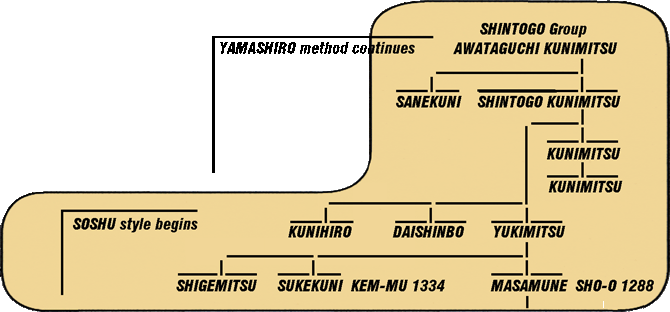©
Copyright
Robert Cole
2015
- No copying
or
distributing
Sagami
- SOSHU
School Roots
YAMASHIRO
method continues in
Kamakura town
|
Sword-Making
at Yamanouchi
|
 
 
|
Roots:
_______________________
AWATAGUCHI KUNIIYE BUN-JI 1185
________________|___
AWATAGUCHI KUNITSUNA KEN-CHO 1249
|________________________________
________________| ___ ______________|___
YAMANOUCHI KUNIMITSU HO-JI 1247 YAMANOUCHI SANEKUNI SHO-GEN 1259
_________________________________
SHINTOGO KUNIMITSU (2nd YAMASHIRO) SHO-AN 1199
___________|__________ ____________________
____|___ _____|___ ____|____ -brothers- ____|____
KUNIHIRO KUNIMITSU DAISHINBO YUKIMITSU KA-GEN 1303
____|___ _____|___ ________ |
SUKEKUNI KUNIMITSU SADAKUNI SHO-WA 1312 |
KEM-MU 1334 |
___________ __________ ________________|__________ ___________ ___________
____|____ _____|____ ____|____ _________|___ ____|_____ ____|____ _____|____
YOSHIMOTO TSUNEMITSU YUKISHIGE GORO MASAMUNE SHIGEMITSU MITSUFUSA MITSUYOSHI
SHO-O 1288 to KA-REKI 1326 - SHO-CHU 1324 -
|
|
Sword
Making at YAMANOUCHI
KUNITSUNA KEN-CHO: GOTOBA-TENNO lived out his exile between 1221
¨and 1239 on OKI Island where the OKI GOBAN was conducted.
¨KUNITSUNA was called to KAMAKURA by HOJO TOKIYORI, who had been¨ installed
SHIKKEN in 1246. The SOSHU working date of KEN-CHO 1249 is therefore supported.
See YAMASHIRO AWATAGUCHI KUNITSUNA - 6th son
SANEKUNI SHO-GEN (t: KUNITSUNA): YAMANOUCHI JU. To KA-GEN 1303.
ITAME HADA. SUGUHA and KO-MIDARE BA.
YAMANOUCHI JU SANEKUNI
KUNIMITSU HO-JI (f: KUNITSUNA): YAMANOUCHI JU. This listing has created confusion
with SHINTOGO KUNIMITSU, as all ¨SOSHU KUNIMITSU smiths are part of
the SHINTOGO Group.
MOKUME HADA. HOSO-SUGUHA nd MIDARE BA, AWATAGUCHI style
SHINTOGO EI-NIN 1293 (f: AWATAGACHI KUNIMITSU): SHINTOGO. SHINTOTARO. Overall
style is comparable with his father. His work years are given
as the first year of EI-NIN 1293 to GEN-KYO 4, some 37 years span.
Prolific career, many TANTO noted for wide MUNE. Pace setter for
Tanto Sugata. His could be called Shintogo Sugata as they invariably
conform to his very particularly refined shape in MU-SORI or
UCHIZORI TANTO SUGATA.
KO-ITAME KO-MOKUME has O-HADA with JI-NIE and CHIKEI. His JI-NIE and
surface steel, generally, reminds of AWATAGUCHI NIE JI-BA.
HAMON is CHU-SUGU or HOSO-SUGU holding a careful MIDARE BA.
Famous for OKINA HIGE "Old Man's Beard" - NIE drifts that fall
into the JI at BOSHI. ARA-NIE in BOSHI and KAERI while YAKI-HABA
narrows and "withers" as it meets the HA.BOSHI are a complex
YAKI-KOMI crowding. KO-MARU KAERI.
Signature Note: His taking HASEBE in his MEI has been conjectured
to derive from KAJI forges near HASEDERA in YAMATO.
See Tokubetsu Juyo Shintogo Tachi and Tanto
KUNIMITSU
SHINTOGO KUNIMITSU
KUNIMITSU KAMAKURA JUNIN
SHINTOGO HASEBE KUNIMITSU
KAMAKURA JUNIN SHINTOGO KUNIMITSU SAKU
SAGAMI-no-KUNI KAMAKURA JU HASEBE KUNIMITSU
KAMAKURA JU SHINTOGO KUNIMITSU HOSHI KOSHIN
SAGAMI-no-KUNI KAMAKURA JUNIN SHINTOGO KUNIMITSU
HOSHI HOMYO KOSHIN
|
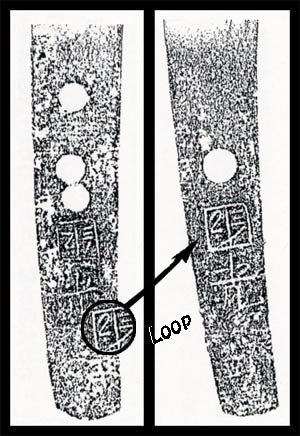
|
|
Shintogo
Kunimtsu

|
Shintogo
Kunimtsu
Hira-tsukuri,
Mitsu-mune, somewhat
wide-bodied and with the
very slightest of curve. The
wide blade would say it is
late, but it retains the
general style of the
Awataguchi.
Itame Hada has strong JiNie
and Chikei.
Hoso-Suguha in Ko-Nie.
Monouchi shows strong Nie,
separating in a refined Niju
style.
Boshi is Ko-Maru, help deep,
medium Kaeri.
Furisode Nakago has one
Mekugi-ana. Signed in the
middle.
Kunimitsu |
|

Shintogo
- 23cm
|
|
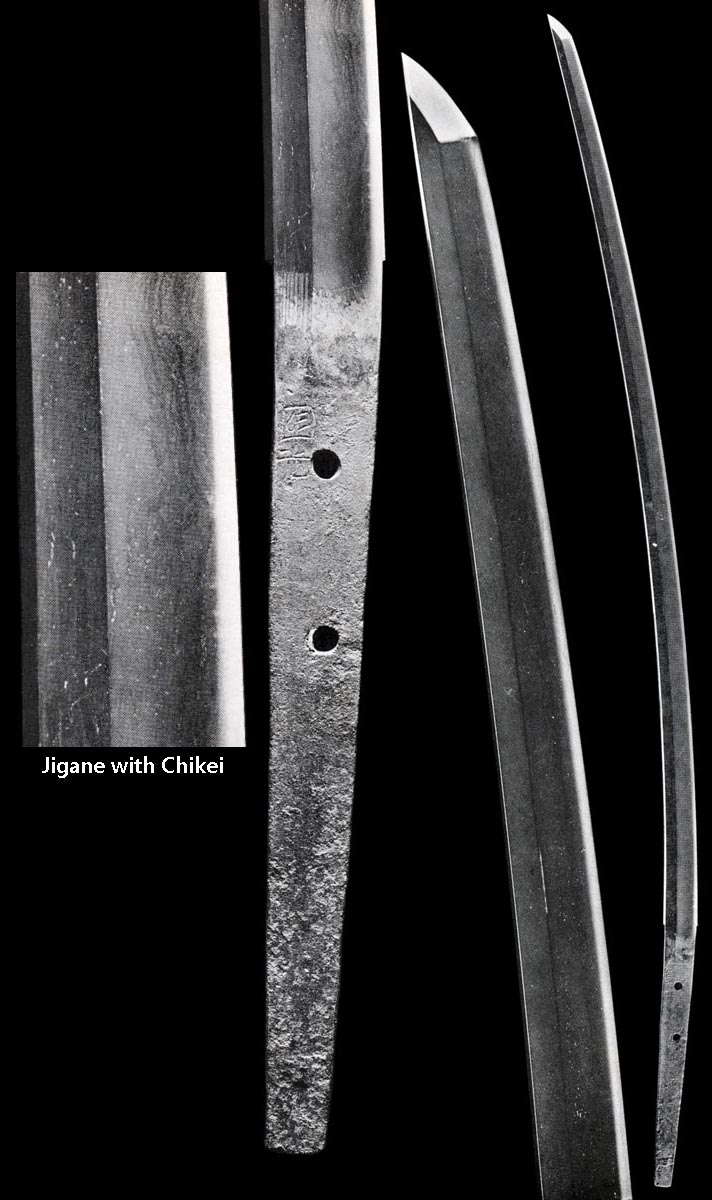
Shintogo
Kunimitsu Tachi - Kokuho
Nagasa:
74.2cm
Moto-Haba: 2.6cm
Shinogi-Tsukuri,
Ihori-Mune, Koshizori, narrow
Mihaba,
Funbari Ko-Kissaki Tachi.
Standing Ko-Itame Hada has profuse
Ji-Nie and Strong Chikei.
Ko-Nie Deki Hoso-Suguha with Kinsuji
and Nijuba.
Hoso-Sugu KoMaru Boshi.
Ubu Nakago has two Mekugi-ana.
Signed in the upper Ji.
Kunimitsu
|
|
Juyo
Shintogo Tachi
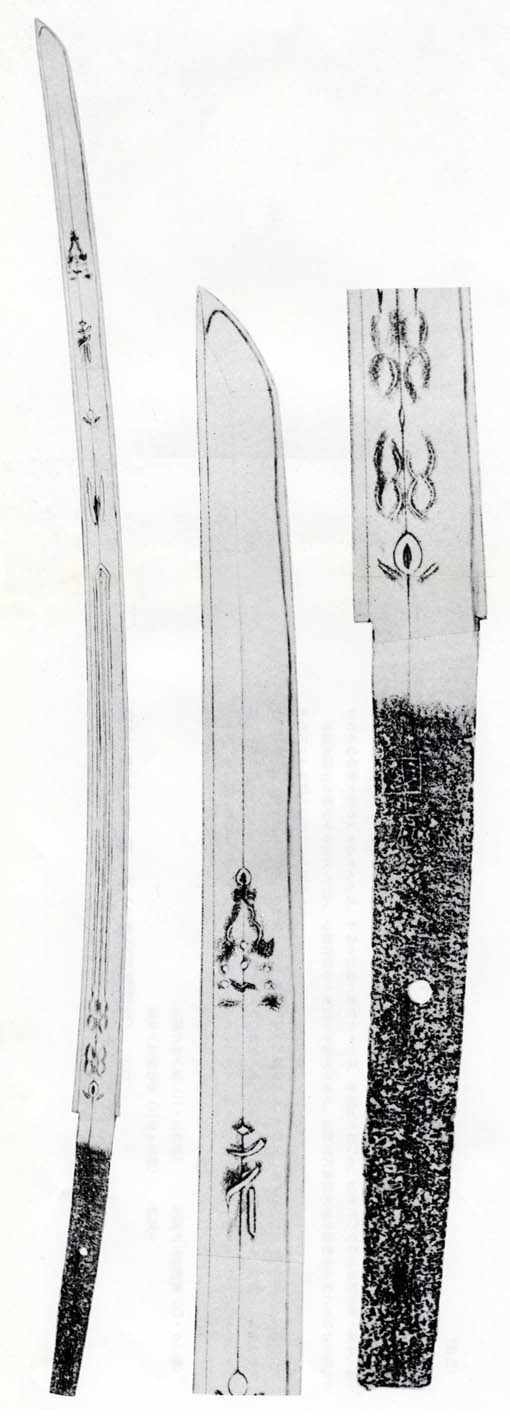
Juyo
Shintogo Tachi - Meibutsu Shintogo
Nagasa:
2 Shaku 5 Sun 1 Bu
(76.1cm)
Sori: 8 Bu 5 Rin
(2.58cm)
Motohaba: 9 Bu 6 Rin
(2.9cm)
Saki-haba: 6 Bu
(1.8cm)
Kissaki-Nagasa: 9 Bu
(2.6cm)
Nakago: 6 Sun 4 Bu
(19.5cm)
Shinogi-tsukuri,
Ihori-mune, Chu-Kissaki,
Koshizori Tachi Sugata.
Ko-Itame Hada with Jinie. There
is Chikei.
Hamon is a gently undulating
Hoso-Suguha in Ko-nie and tight
Nioi-guchi. Ko-Ashi and Kinsuji
play hide and seek.
Sugu Komaru Boshi.
Many Horimono - Tengai Priest's
Hood, Bonji, Rendai Lotsu
Pedestal, Kuwa-kata, Sanko Ken,
and Bonji.
Slight Nakago-zori to slightly
rounded KiriJiri.
Tachi-Ubu, single mid-placement
Mekugi-ana.
Signed:
Kunimitsu
|
|
Den
Kunimitsu - Kokuho
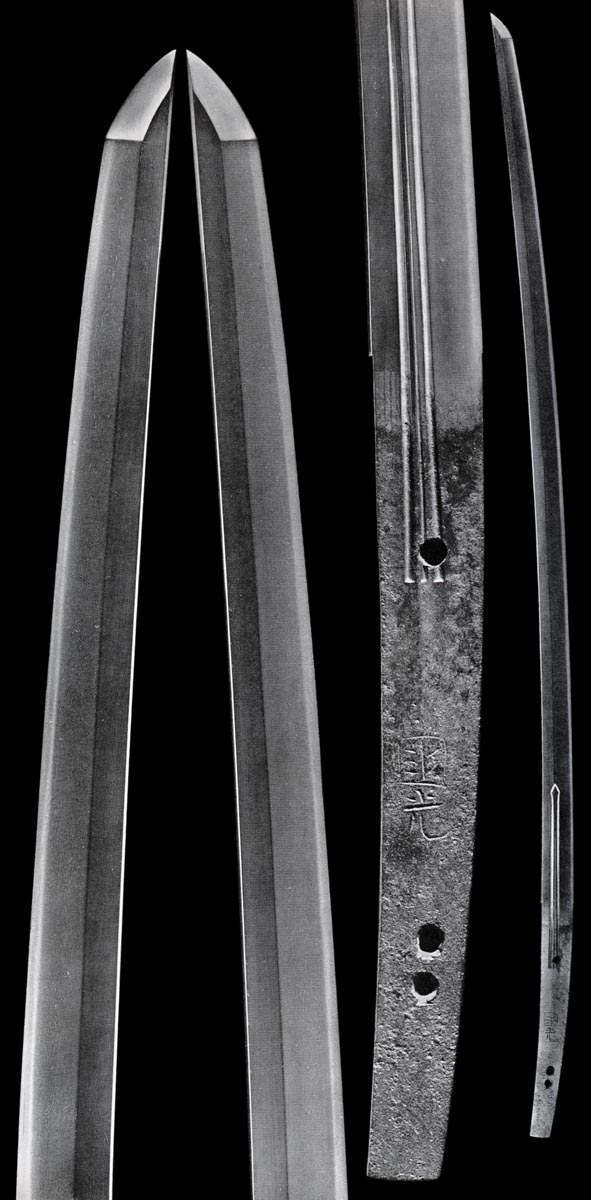
Den
Kunimitsu - Kokuho
Nagasa: 73.2cm
Moto-Haba: 2.6cm
Shinogi-Tsukuri,
Maru-Mune, Ko-Kissaki Tachi.
Su-Ken Horimono.
Ko-Itame Hada has thin Ji-Nie and
Chikei.
Tight Nioi-Guchi and Ko-Nie
Hoso-Suguha with Ashi-iri and
Kinsuji.
Hoso-Sugu Ko-Maru Boshi.
Suriage Nakago has three
Mekugi-ana. Signed across the
Shinogi.
Kunimitsu
|
|
Meibutsu Aizu
Shintogo - Kokuho
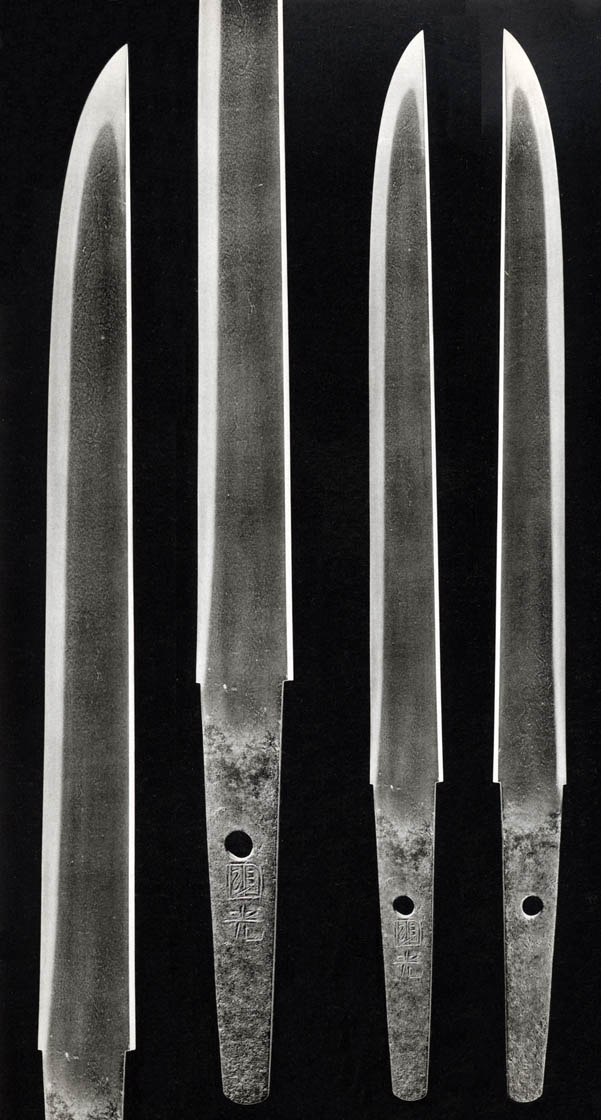
Meibutsu
Aizu Shintogo
Sword
of Gamo Ujisato, Lord
of Aizu
Fought in support of
Hideyoshi, and may
have died of it.
Supposedly a
poisoning.
Nagasa: 8 Sun 4 Bu
(25.45cm)
Uchizori
Motohaba: 7 Bu
8 Rin (2.36cm)
Nakago: 3 Sun
6 Bu (10.91cm)
Hira-tsukuri,
Mitsu-mune.
Itame, Mokume mixed
with strong JiNie
and Chikei.
Chu-Suguha in
Ko-Nie.
Ko-maru is found
deep, with slight
Hakikake
and long fall Kaeri.
Ubu, one Mekugi-ana
and signed in the
middle.
Kunimitsu |
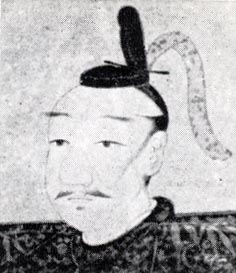
Gamo
Ujisato
|
|
|
|
Shintogo
Kunimitsu - Kokuho

Shintogo
Kunimitsu - Kokuho
Nagasa:
26.6cm
Moto-Haba: 2.2cm
Hira-tsukuri,
Mitsu-mune, Uchizori Tanto.
Ko-Itame Hada has Ji-Nie and
Chikei.
Hoso-Suguha with Mura-Nie. Kinsuji
is seen in the mid.
Sugu Nijuba Boshi is Ko-Maru Kaeri.
Ubu Kurijiri, one Mekugi-ana.
Signed in the center.
Kunimitsu
|
|
Juyo Bunkazai Kunimitsu
Tanto

Juyo Bunkazai
Kunimitsu Tanto
Nagasa:
9 Sun 1 Bu 6 Rin
(27.75cm)
Uchizori
Motohaba: 8 Bu
(2.4cm)
Moto-kasane: 2 Bu
(0.6cm)
Nakago: 3 Sun 6 Bu
5 Rin (11.1cm)
Nakagozori: Slight
Hira-tsukuri,
Mitsu-mune, Uchizori Tanto
Sugata. At 9 Sun 1 Bu, it
is similarly long with the
famous Kokuho National
Treasure which is 8 Sun 4
Bu. There is a Shintogo
Tanto that is Kyushin
possession of the Murauji
family of 9 Sun 3 Bu.
Ko-Itame Hada has Chikei
and thick, shinning Jinie
over the surface. We can
see his very special style
of Jitetsu treatment was
passed on to Masamune.
Hamon is Suguha in deep
Nioi-fukashi and abundant
Ko-Nie. Kinsuji develops
in the mid. A Koshiba
stands guard at the Machi.
Sugu Komaru Boshi has an
inner Yubashiri from which
strong Kinsuji falls in
the Whiskers form. His
special trait is a
crowding of complexity and
subtleties at the Boshi.
A gentle curve to the
Nakago; there are three
Mekugi-ana. The upper is
notched from multiple
mounts.
Signed:
Kunimitsu
This piece is dated to Einin
Gennen 1293 |
|
|
|
Shintogo
Kunimitsu - Juyo Bunkazai
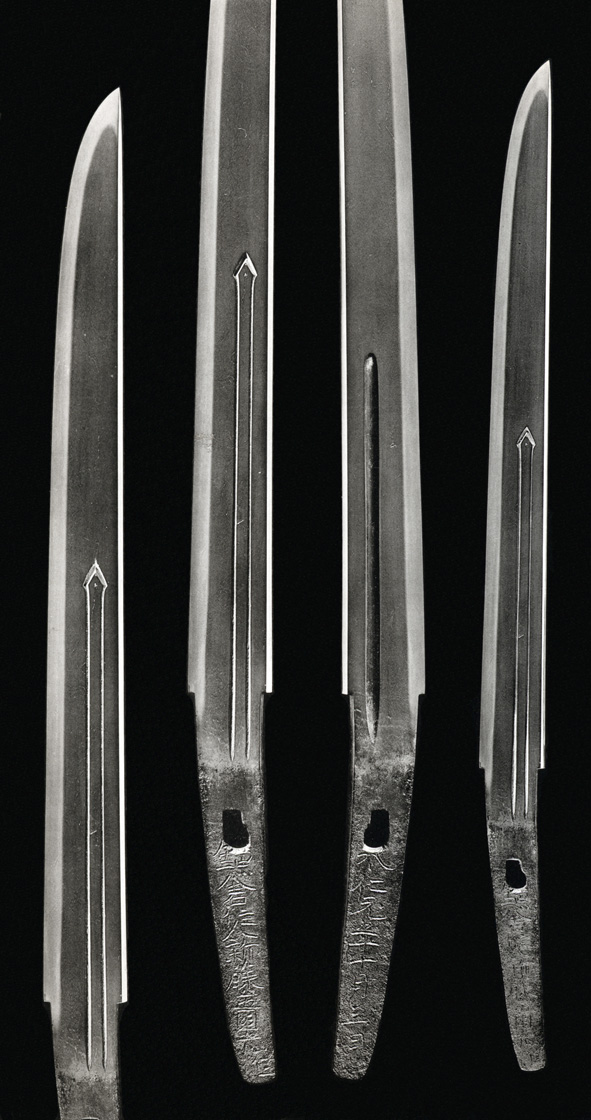
|
Shintogo
Kunimitsu
Nagasa: 7 Sun
7 Bu (23.48cm)
Slight,
essentially
Musori
Motohaba: 6 Bu
8 Rin (2.06cm)
Moto-kasane: 1
Bu 8 Rin
(0.55cm)
Nakago: 3 Sun
3 Bu (10cm
Hira-tsukuri, Mitsu-mune.
Suken Omote with medium
Koshibi on Ura.
Ko-Itame Hada has Ji-Nie
and Chikei.
Chu-Suguha in Ko-Nie with
defined Sunagashi and
Kinsuji.
Ko-Maru has slight
Hakikake and a short turn
near the Mune.
Ubu nakago is swept back
with one Mekugi-ana from
multiple mounts.
Signed:
Kamakura Junin Shintogo
Kunimitsu Saku
Einin Gennen Ju Gatsu-San
Hi - 1302
|
|
YUKIMITSU School
SHINTOGO KUNIMITSU
|
YUKIMITSU KA-GEN 1303
________________|___________ ____________ __________ ___________ ___________
____|____ _________|___ ____|_____ ____|____ ____|_____ ____|____ _____|____
YUKISHIGE GORO MASAMUNE SHIGEMITSU YOSHIMOTO TSUNAMITSU MITSUFUSA MITSUYOSHI
SHO-O 1288 to KA-REKI 1326 - SHO-CHU 1324 -
|
|
YUKIMITSU
KA-GEN (t: SHINTOGO): Senior pupil with MASAMUNE.
TOSABURO. Son and student. Helped
create the early Soshu-den style.Works are seen
from KA-GEN to KEM-MU. ZAIMEI TANTO should
be
expected with two character signature. 8 SUN
NAGASA, evenly wide, MITSU-MUNE with no SORI.
Most long swords will be O-SURIAGE, IHORI-MUNE,
thin blades with normal KISSAKI.
JI-TETSU is standing ITAME-HADA with SHIRA-KE and
CHIKEI. There will be JI-NIE.
HAMON: HOSO-SUGUHA, CHU-SUGUHA, KO-MIDARE BA.
Undulating line of GUNOME-MIDARE BA
of NIE with KINSUJI and SUNAGASHI. HORIMONO are
fine carving in a frame with SUKEN and
GOMABASHI.
KURIJIRI or FURISODE NAKAGO surface has a slight
NIKU with KATTE-SAGARI YASURI.
There are a relatively high number of
extant pieces. Early works are straight patterns
of Ko-Midare. Later we
see O-MIDARE of NOTARE-MIDARE BA and HITATSURA BA
in the style of MASAMUNE and NORISHIGE.
Texts mention a similarity with TAIMA style.
See Tokubetsu Juyo
Yukimitsu
YUKIMITSU
SAGAMI-no-KUNI JUNIN YUKIMITSU
SHIGEMITSU KO-AN 1278 to SHO-CHU 1324 (t: YUKIMITSU):
SOSHU KAMAKURA JU SHIGEMITSU
SAGAMI-NO-KUNI JUNIN SHIGEMITSU
YOSHIMOTO SHO-KEI 1332 YUKIMITSU DEN. YAMANOUCHI JU. Also signed SUKEMORI and YOSHIMITSU.
Date is prior to destruction of KAMAKURA.
YUKISHIGE KO-AN: YUKIMITSU DEN. Early date. Also signed SUKEHARU. Said to have joined MASAMUNE.
SAGAMI KAMAKURA
SOSHU JU SUKEHARU
MITSUYOSHI KEM-MU 1334: YAJIRO. KAMAKURA JU.
MITSUFUSA SHO-CHU 1324 (t: YUKIMITSU): YAMANOUCHI Smith. ITAME HADA with JINIE.
SUGUHA, SOSHU O-MIDARE BA on rolling NOTARE HAMON line.
SOSHU JU MITSUFUSA
|
Yukimitsu
Tanto - Kokuho

Yukimitsu
Tanto - Kokuho
Nagasa:
26.2cm
Moto-Haba: 2.3cm
Hira-tsukuri,
Mitsu-Mune, Uchizori Tanto.
Ko-Itame Hada has Ji-Nie.
Chu-Suguha with Ashi of clear Nioi
and Ko-Nie flows to Kuzure
Yakidashi.
Togari at the head falls in long
Kaeri.
Ubu, Furisode Kimono Sleeves Nakago
has one Mekugi-ana.
Yukimitsu
|
|
Juyo Bijutsu Hin
Yukimitsu

Juyo Bijutsu Hin
- Meibutsu Goto Yukimitsu
Nagasa: 8
Sun 4 Bu(25.4cm)
Uchizori
Motohaba: 6 Bu 6 Rin
(2.0cm)
Moto-kasane: 1 Bu 8 Rin
(0.55cm)
Nakago: 3 Sun 1 Bu (9.6cm)
Hira-tsukuri,
Uchizori, Mitsu-mune of
Kamakura Jidai Sugata.
Itame Hada with O-Hada mix
shows Chikei. Yukimitsu Nie
is particularly beautiful
and splendid.
Hamon is a reserved Notare
Fukashi in deeply thick
Ko-Nie. Kinsuji cuts through
figures while Inazuma
strikes into the Ji.
Notare-Komi Boshi to a sharp
Ko-maru and direct fall of
the Kaeri.
Ubu, two Mekugi-ana, one
filled. Mu-mei |
|
|
Juyo Yukimitsu
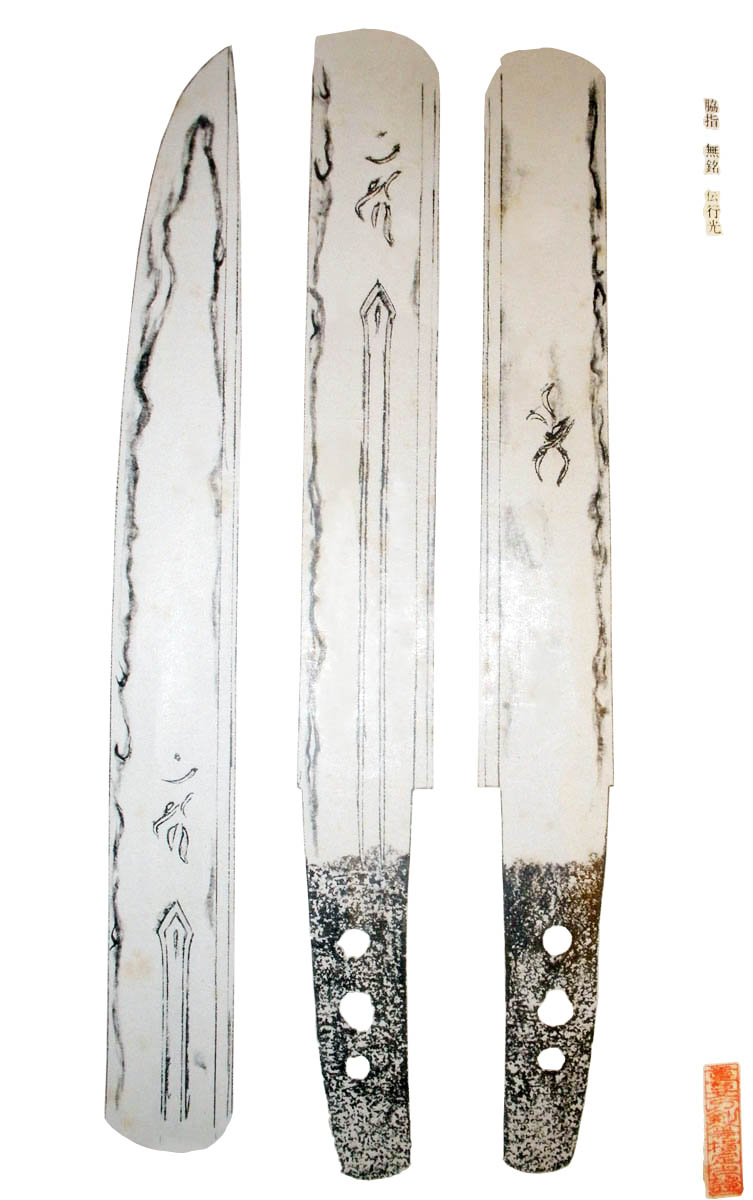
Juyo Yukimitsu
Nagasa: 30.6cm
Sori: Uchizori
Motohaba: 2.6cm
Nakago: 8.5cm
Nakagozori: Slight
Hira-tsukuri, Mitsu-mune with thin
Kasane. Mihaba is wide.
Small elongation in the Kissaki and
Uchizori Sugata.
Itame with strongly standing O-Hada
and Chikei.
Jinie and Jifu dapples the surface
of the gently undulating
Gunome-Midare Ba Soshu Hamon where
Ashi and Yo finds deeply running
Sunagashi and Kinsuji. There is much
Nie and Yubashiri seen. Mune-yaki
dapples along the back.
Notare-Komi Boshi resolves in small
Ko-maru and a long fall.
Katte Sagari Yasuri with slight
Furisode curve. Mumei
|
SAGAMI - SOSHU School
DAISHINBO EI-NIN (t: SHINTOGO, br: YUKIMITSU): SAGAMI JU.Studied along
side YUKIMITSU. NIKKO-YAMA HOSHI Priest. Also signed KUNIYASU.
Fine HORIMONO carver.
KUNIYASU
DAISHINBO
DAISHIN HOSHI SUKEYOSHI
KUNIHIRO GEN-KYO 1321 (f: SHINTOGO): GOJIRO. Lived in KAMAKURA. Always similar
work, he is forever associated with SHINTOGO KUNIMITSU. Some references
claim he is SHINTOGOs' third son with the following lineage:
SHINTOGO KUNIMITSU "Three Sons"
|_______________ _____________
____|____ ____|___ _____|_____________
KUNISHIGE KUNIHIRO KUNIYASU (DAISHINBO)
His sword style resembles that of KUNIMITSU. However, KUNIHIRO is ranked just below
SHINTOGO as his influences were acquired during KUNIMITSU's declining years. Work from
BUN-PO 1317 to GEN-TOKU 1329. TANTO and short swords are seen. KAMAKURA style TANTO can
be 8 SUN, MUZORI or UCHIZORI. Light JI-NIE over the JI-TETSU. KO-NIE on deep NIOI-FUKASHI
SUGUHA and gently moving KO-MIDARE BA.
KUNIHIRO
HASEBE KUNIHIRO
KUNIHIRO KAMAKURA JUNIN
SAGAMI-no-KUNI KAMAKURA JUNIN HASEBE KUNIHIRO
SUKEKUNI KEM-MU (f: KUNIHIRO): KO-ITAME HADA. SUGUHA and KO-MIDARE BA.
SOSHU YAMANOUCHI JU SUKEKUNI
KAMAKURA YAMANOUCHI JU SUKEKUNI
|
Bunkazai Kunihiro
Tanto
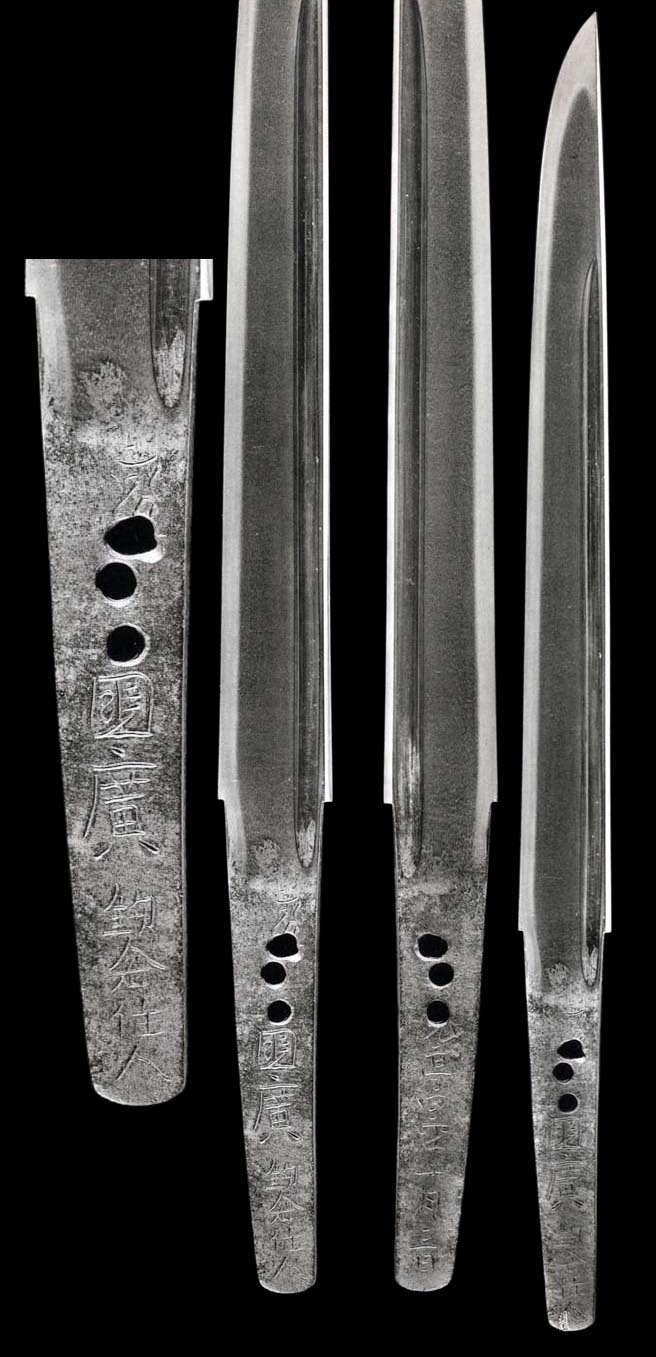
Bunkazai
Kunihiro Tanto
Nagasa: 8
Sun (24.2cm)
Uchizori
Motohaba: 7 Bu 6 Rin (2.3cm)
Moto-kasane: 2 Bu (0.6cm)
Nakago: 3 Sun 4 Bu (10.4cm)
Ko-Itame
Hada with Jinie. Suguha in fine
Ko-Nie where Kinsuji plays.
His date places scholarship. Three
Mekugi-ana, multiple mounts.
Slightly stretched second character,
his Mei is clear:
-Bonji-
Kunihiro - Kamakura junin
Genkyo Yonen Ju-Gatsu Mikka ~
Third Day
|
|
